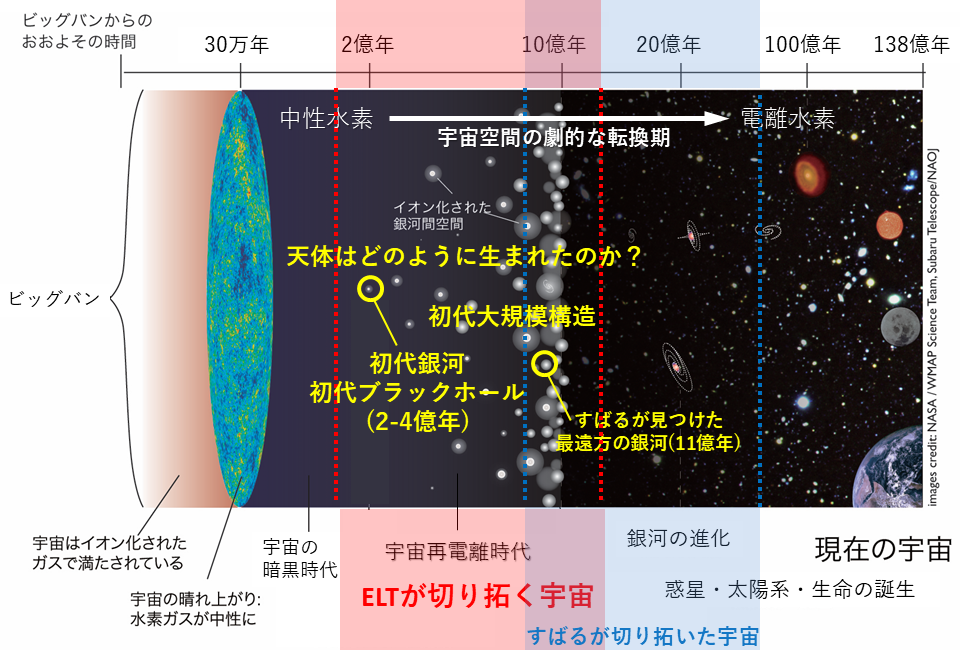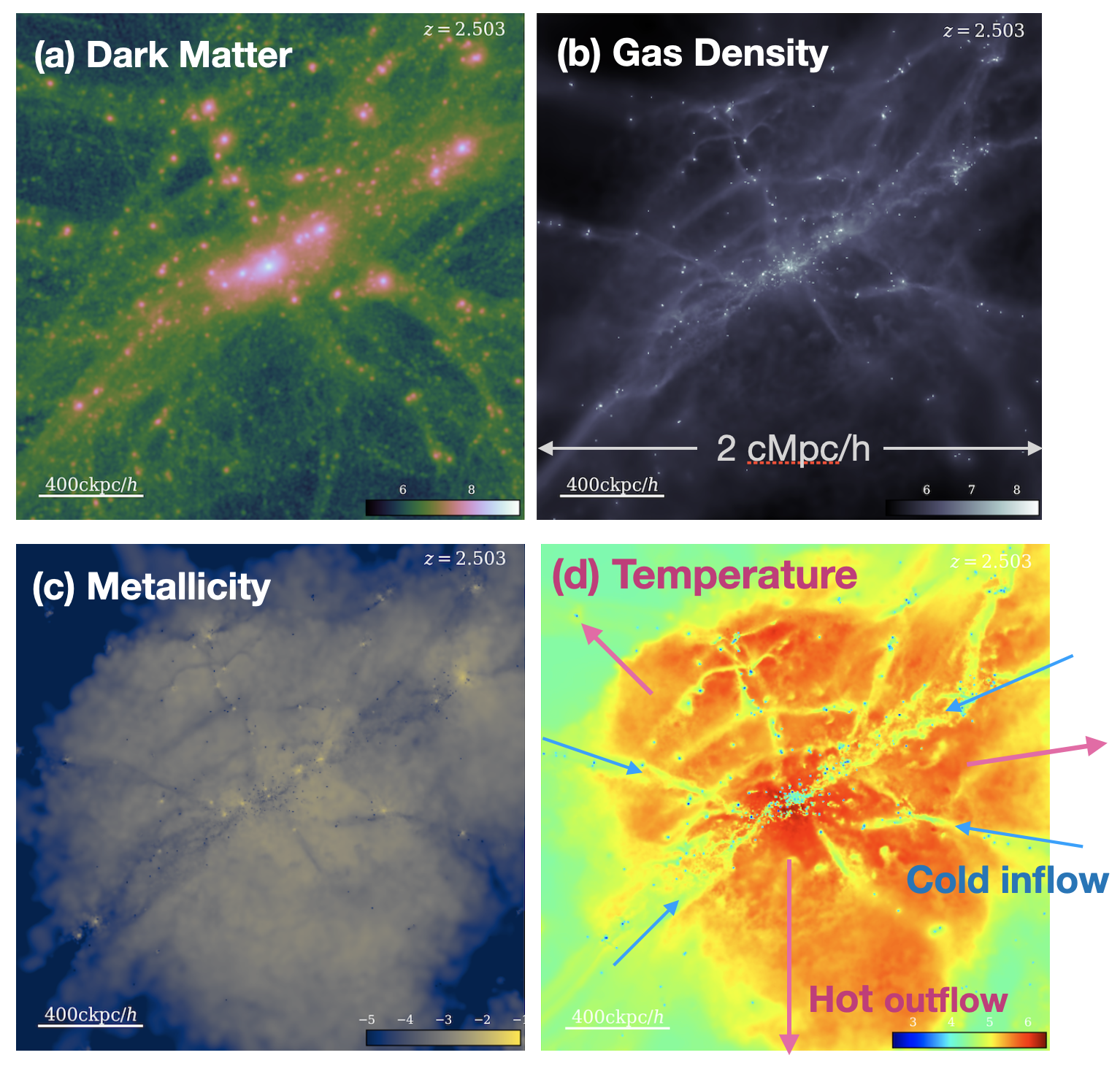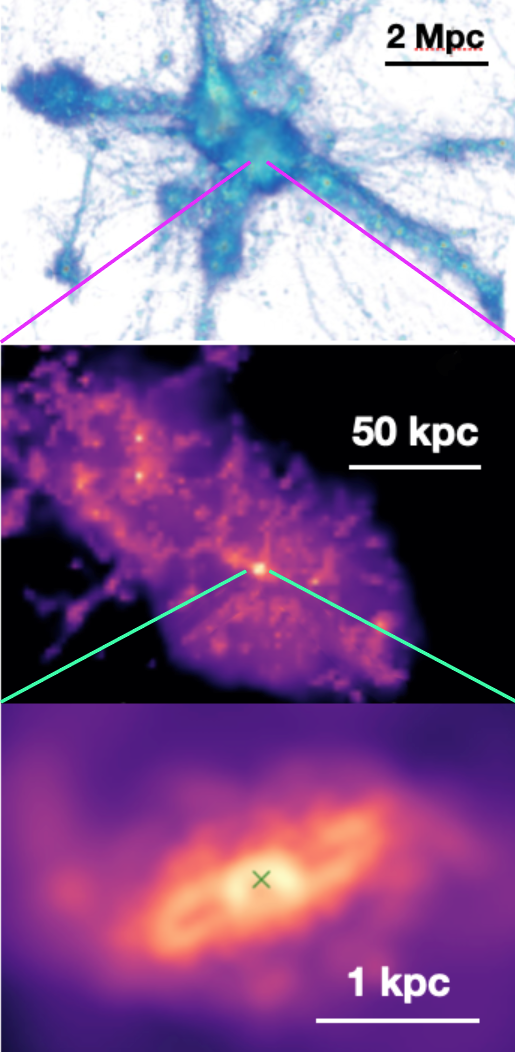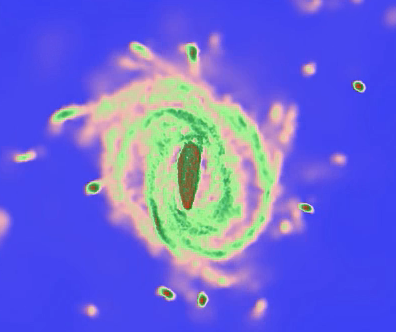Science
First Stars, First Galaxies, SMBH
The first stars in the universe are thought to have formed about 100 million years after the Big Bang, followed by the formation of the first galaxies and supermassive black holes. The formation of these objects in the early universe is an important process that promotes the most ionization of the universe and lays the foundation of the current universe. Therefore, we are studying the formation of the first stars, the first galaxies, and supermassive black holes from both theoretical and observational viewpoints to understand how they formed.
As part of our theoretical research, we perform various fluid simulations mainly using supercomputers. We are investigating the processes from the mass accumulation of baryons and dark matter to the formation of primary galaxies by performing cosmological structure formation simulations that take into account feedback effects such as supernova explosions and active galactic nuclei. Based on the simulation results, the formation frequency and properties of primary galaxies and the possibility of future observations are discussed. In addition, high-resolution zoom-in simulations are performed to understand the mass growth process of individual stars and black holes that make up the first galaxies. By understanding the mass distribution of primary stars and the growth rate of black holes left behind after their death, we are trying to clarify the formation process of the first supermassive black holes in the universe.
On the other hand, the formation of galaxies and supermassive black holes in the deeper Universe are currently being discussed by JWST based on the results of Subaru Telescope and HST. The ELT is expected to reveal the detailed inner structure of distant galaxies with its high light-gathering power and high spatial resolution by adaptive optics. The ELT is expected to reveal the detailed inner structure of distant galaxies. We are making the best preparation for the ELT era to make the exploration of the distant universe more fruitful in the framework of the International Leading Astronomical Consortium, in which there is no boundary between theory and observation.


Galaxy Formation, Protoclusters


Cluster of galaxies and the large-scale structure of the Universe
According to the theory of hierarchical structure formation, small structures are formed first in the Universe, which gradually accumulate gravitationally to form galaxies and galaxy clusters. Eventually, a huge bubble-like structure called the large-scale structure of the universe is formed.
The cosmic large-scale structure contains a great deal of important information that can help us understand the evolutionary process of the Universe. For example, the strength of the clustering of galaxies contains information about the accelerated expansion of the Universe, and the geometry of the Universe can be determined from the peak positions of baryon acoustic oscillations(BAO) in the clustering signal. Furthermore, the anisotropy of the clustering can provide insight into the theory of gravity.
Gravity plays a dominant role in the evolution of the large-scale structure of the Universe, and about 85% of the gravitationally active constituents in the universe are dark matter, a mysterious material that cannot be observed with light. The gravitational lensing effect allows us to indirectly observe dark matter, which cannot be observed directly.
We have been analyzing the gravitational lensing effect using survey data from the Hyper Suprime-Cam (HSC) on the Subaru Telescope. Our results, along with those of the U.S.-led Dark Energy Survey (DES) and the European-led KiDS survey, have provided constraints on cosmological models. In the next stage, we will use this experience to further refine and validate our cosmological model, in collaboration with the Vera Rubin Observatory’s LSST and space telescope missions such as Nancy Grace Roman and Euclid.
We will work primarily with the University of Arizona and CCA to develop various levels of analysis pipelines and methods.
Production/assembly of ELT MORFEO mirror:
ULTIMATE WFI Mid-band filter production:
Production of HSC intermediate band filters:
The HSC camera installed on the prime focus of the Subaru Telescope can be equipped with a number of optical filters. HSC is originally equipped with five broadband filters (g, r, i, z, and Y), and a variety of narrow-band filters are also available. We will produce a group of optical filters (intermediate band filters) that continuously and relatively high-resolutionly split the visible wavelength range from 400 nm to 1000 nm. These filters play a very important role in accurately estimating the redshift of galaxies, which is essential for the observation of gravitational lensing effects.
In addition, it can provide important data for various galaxy physics and cosmology, such as the precise selection of Lyman break galaxies and the correlation of statistical shapes of galaxies (intrinsic alignment).